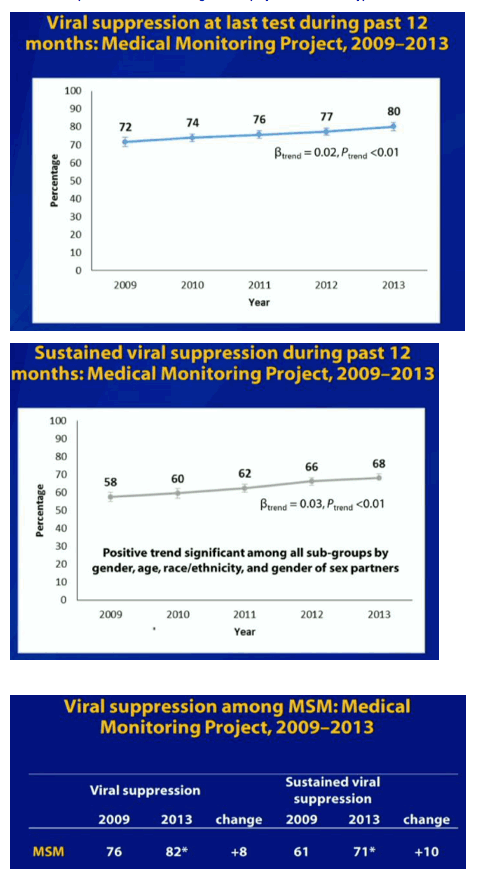 |
 |
 |
| |
HIV Suppression Rate Rose Significantly in US From 2009 to 2013
|
| |
| |
Conference on Retroviruses and Opportunistic Infections (CROI), February 22-25, 2016, Boston
Mark Mascolini
Rates of HIV suppression on the latest viral load test climbed from 72% in 2009 to 80% in 2013 in a nationally representative US sample studied by the Centers for Disease Control and Prevention (CDC) [1]. Women, blacks, and younger people had some of the biggest gains over the 5-year study.
The dearly sought endpoint of the HIV care cascade--an undetectable viral load--promises both individual and population-level health benefits. More aggressive HIV testing and linkage to care, plus more tolerable and convenient antiretroviral regimens, should contribute to climbing viral suppression rates. To see if that's happening, the CDC examined data from the Medical Monitoring Project, a nationally representative sample of people with HIV. Data came from interviews and medical record abstraction. The researchers aimed to determine if rates of viral suppression (a viral load below 200 copies) changed at the last test or at all tests in the last 12 months from 2009 through 2013.
The overall viral suppression rate at the last test rose from 72% in 2009 to 74% in 2010, to 76% in 2011, to 77% in 2012, and to 80% in 2013 (P < 0.01). This improvement held true for all subgroups by gender, age, race/ethnicity, and gender of sex partners. Gains in viral control from 2009 through 2013 proved particular strong for women (66% to 77%), blacks (64% to 76%), 18- to 29-year-olds (56% to 68%), and 30- to 39-year-olds (62% to 75%) (P < 0.01 for all gains).
Rates of sustained virologic suppression for the past 12 months rose from 58% in 2009 to 60% in 2010, to 62% in 2011, to 66% in 2012, and to 68% in 2013 (P < 0.01). This improvement proved significant for all subgroups by gender, age, race/ethnicity, and gender of sex partners. Again, gains looked particularly good for women (52% to 64%), blacks (49% to 61%), 18- to 29-year-olds (32% to 51%), and 30- to 39-year-olds (47% to 63%) (P < 0.01 for all).
For men who have sex with men, the proportion with viral suppression at the last test jumped from 76% in 2009 to 82% in 2013, and the proportion with 12-month sustained suppression in those years surged from 61% to 71% (P
These improving viral suppression rates across groups reflected a steady climb in antiretroviral prescribing rates from 89% in 2009 to 90% in 2010, to 92% in 2011, to 93% in 2012, to 94% in 2013 (beta trend = 0.01). Statistical adjustment for rising antiretroviral prescription rates trimmed the average annual gain in viral suppression at the last test by 30%, but that increase remained statistically significant for all subgroups except 18- to 29-year-olds. Adjustment for rising antiretroviral rates also dampened the average annual increase in sustained viral suppression by 19% overall, and the trend remained significant for all subgroups. These findings indicated that rising antiretroviral prescription rates accounted for some but not all of the improving viral suppression rates.
The CDC investigators suggested a few factors that contributed to improving viral suppression rates over time--antiretroviral guideline changes in 2009 and 2012 and elimination of ADAP wait lists in 2013. They observed that the largest improvements in suppression rates came in subgroups with the lowest rates when the study period began. But they cautioned that "more progress is needed to achieve National HIV/AIDS Strategy goals."
WEBCAST: http://www.croiwebcasts.org/console/player/29468?mediaType=audio&

Reference
1. Bradley H, Mattson C, Beer L, Huang P, Shouse RL. Increased HIV viral suppression among US adults receiving medical care, 2009-2013. Conference on Retroviruses and Opportunistic Infections (CROI), February 22-25, 2016, Boston. Abstract 53.
|
| |
|
 |
 |
|
|